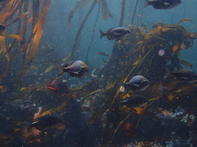
The South African seaweed industry uses two types of kelp, Ecklonia maxima and to a lesser extent Laminaria pallida, as well as three species of red seaweeds of the genus Gelidium and Gracilaria/Gracilariopsis. Ulva species are green seaweed used for abalone feed.
Species of Kelp

Ecklonia maxima
The harvestable large kelp Ecklonia maxima grows on rocky parts of the South African coast from north of Luderitz and south to the Cape Peninsula up to Cape Agulhas. Shallow coastal areas have a high density of short plants, but in deeper water Ecklonia grows less dense. The average biomass in a fairly dense kelp bed is 10-15 kg/m². This kelp is used to make a plant growth stimulant and as feed for abalone.
Laminaria pallida
The kelp L. pallida grows from Danger Point on the south coast to Namibia and is found as a sub-canopy under Ecklonia and in deeper water of up to 20 m. The average wet biomass is around 8 kg/m². Laminaria is used in the Namibian seaweed industry as a soil-conditioner, in cosmetics and beauty treatments.
Species of Seaweed

Green Seaweed
Ulva armoricana, is grown commercially around the west to the east coast of South Africa. It has a high growth rate and is easy to pick. Ulva species are currently South Africa’s largest aquaculture product by volume and has grown by 448% from 2006 to 2012. Ulva species are used as supplementary feeding in abalone farming and can be used as a plant growth stimulant.
Other seaweed species that have been tested for abalone food include, Plocamium corallorhiza and Porphyra capensis.
Gelidium pristoides
This small red algae species is found from Kommetjie on the Cape Peninsula to Port Edward on the Wild Coast in the Eastern Cape/KwaZulu-Natal. It grows about 15 cm tall and wet biomass is 150 - 200 g/m².
This seaweed yields the highest agar of the Gelidium species - between 30% and 48% of dry weight. It was harvested in the 1950s from the Eastern Cape and exported to Japan and Korea. Efforts to extract agar in the Eastern Cape proved uneconomical.
Gracilaria gracilis
Buried in the sandy substrate along the South African coast, from Luderitz to False Bay, it forms loose tufts and grows to 50 cm high, covering large areas of sheltered bays and estuaries. The biomass varies from a few grams to several kilograms per square meter.
This red seaweed occurred in commercial quantities around World War II in Saldanha Bay, when it was harvested and exported, but due to developments in the bay has all but disappeared. The commercial production on floating tubular netting in the 1990s has been abandoned. It can be used as a supplementary feed grown in integrated systems with abalone on abalone farms.
Gelidium abbottiorum
This small red seaweed is found as 30 - 40 cm high scattered tufts from Cape Agulhas to northern KwaZulu-Natal. It grows in rock pools and deeper water and biomass varies from a few grams to hundreds of grams per square metre. This is considered a less valuable species.
Gelidium pteridifolium
Growing as tufts about 20 cm high, this red seaweed is found from False Bay up to the north of Durban and is most prolific in the Eastern Cape. The biomass varies from a few grams to hundreds of grams per square metre. This is considered a less valuable species.
By Marinda Louw